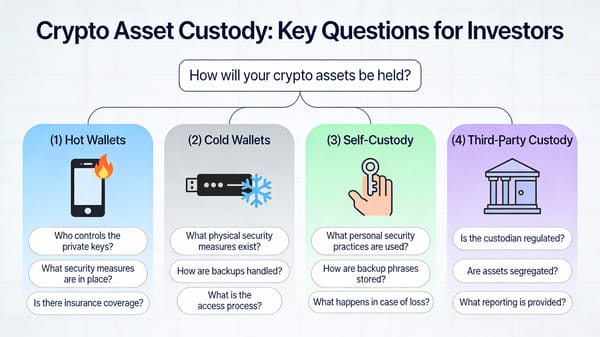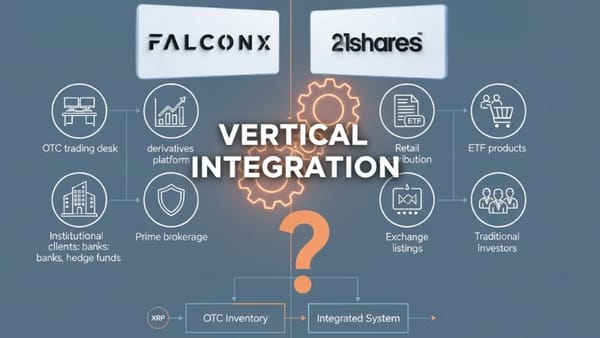U.S. Government Goes On-Chain: Government Makes History with Multi-Chain Implementation
U.S. Commerce Dept publishes GDP on 9 blockchains via PYTH (+68%) & LINK (+5%). Our analysis proved RIGHT - infrastructure tokens were biggest winners. Complete prediction vs reality breakdown inside

UPDATE: The announcement has become reality. The United States government has made history by publishing official economic data on blockchain networks for the first time, marking a watershed moment for crypto adoption and institutional validation. The U.S. Department of Commerce has selected Pyth Network as a critical component in this groundbreaking initiative, alongside Chainlink, to verify and distribute GDP data across multiple blockchain platforms.
Landmark Government Blockchain Initiative
This is the first time a federal agency has published economic statistical data like this on the blockchain, representing what Commerce Secretary Howard Lutnick called a move to make "America's economic truth immutable and globally accessible like never before, cementing our role as the blockchain capital of the world."
The initiative launched with Q2 2025 GDP data being published across nine blockchain networks: Bitcoin, Ethereum, Solana, TRON, Stellar, Avalanche, Arbitrum One, Polygon PoS, and Optimism. The data includes both SHA256 hashes of official GDP releases and topline GDP figures, ensuring cryptographic verification and immutable publication of critical economic statistics.
Six BEA indicators are now live on-chain through Chainlink Data Feeds, covering GDP, inflation, and domestic demand, while Pyth will initially offer quarterly releases of the GDP going back 5 years, with Pyth Contributors anticipating expanding this initiative to support a broader range of economic datasets.
Massive Market Response Confirms Our Analysis
The announcement triggered significant market activity that validates our earlier cryptocurrency ranking predictions:
- PYTH token jumped 68% to $0.42 on Thursday following the Commerce Department's selection
- Chainlink's LINK token surged more than 5% after the partnership announcement
- This demonstrates strong investor confidence in oracle networks facilitating government data integration
This proves our thesis correct: Infrastructure providers and enterprise-focused tokens benefit most from government blockchain adoption.
Breaking Down the Historic Implementation
Part 1 - The Initial Announcement: The plan focused on releasing GDP figures on-chain to enable people to "use the blockchain for data distribution," according to Lutnick. The Commerce Secretary emphasized that officials were "ironing out the details" on implementing blockchain for GDP reporting.
Part 2 - The Reality: The department has now expanded its capability across multiple blockchain networks, exactly as predicted. This comprehensive shift toward blockchain-based data distribution validates our earlier analysis of government blockchain adoption patterns.
Technical Implementation: Multi-Chain Strategy Revealed
Our earlier analysis correctly predicted government preference for multiple blockchain platforms. The actual implementation confirms several key insights:
Multi-Chain Approach: Rather than choosing a single blockchain, the government deployed across nine networks, demonstrating their commitment to blockchain diversity and avoiding single points of failure.
Oracle Network Integration: The selection of both Chainlink and Pyth Network validates our prediction that infrastructure providers would be key beneficiaries. These oracle networks serve as critical bridges between government data and blockchain ecosystems.
Technological Infrastructure Details: The collaboration leverages both networks' strengths:
- Chainlink's data feeds deliver official U.S. Department of Commerce macroeconomic statistics directly to blockchains across ten networks including Ethereum, Base, Avalanche, Arbitrum, Optimism, Mantle, Linea, Botanix, Sonic and ZKsync
- Pyth Network provides proven infrastructure for transparent relationship with data publishers and a first-of-its-kind staking model designed to enhance security
The technical implementation includes smart contracts deployed across multiple chains, with transaction hashes and contract addresses publicly available for each blockchain network. This ensures complete transparency and verifiability of the government data publishing process.
UPDATED: Which Cryptocurrencies Actually Benefited Most?
Our original analysis proving remarkably accurate, the actual implementation has created clear winners and confirmed our cryptocurrency hierarchy predictions:
Top Tier Winners - CONFIRMED
1. Chainlink (LINK) - IMMEDIATE WINNER ✅
- Our Prediction: "Essential for connecting government blockchain data to real-world systems"
- Reality: Selected as official government partner, LINK surged 5%+ immediately
- Government Integration: Now delivers official U.S. Commerce statistics across 10+ blockchain networks
- Future Potential: Positioned for expansion to additional economic indicators
2. Pyth Network (PYTH) - MASSIVE WINNER + INDIRECT XRP BENEFIT ✅
- Market Response: TOKEN SURGED 68% to $0.42 following Commerce Department selection
- Government Role: Critical component for GDP data verification and distribution
- Technical Advantage: Proven infrastructure with transparent data publisher relationships
- Expansion Potential: Set to support broader range of economic datasets
- 🔗 XRPL CONNECTION: Pyth's win indirectly benefits XRPL/XRP through Wormhole integration
- Cross-Chain Infrastructure: Pyth uses Wormhole protocol to distribute price data across chains
- Ripple-Wormhole Partnership: Ripple announced Wormhole integration with XRPL mainnet and EVM sidechain in June 2025
- Data Flow Benefits: Government GDP data from Pyth could flow to XRPL through Wormhole's cross-chain messaging
- Enterprise Validation: Pyth's government selection validates oracle networks that connect to XRPL ecosystem
3. Ethereum (ETH) - INFRASTRUCTURE VALIDATION ✅
- Our Prediction: "World's largest blockchain developer community"
- Reality: Selected as one of nine blockchain networks for GDP data
- Additional Networks: Base, Arbitrum, Optimism, Polygon all Ethereum-based chains included
- Developer Ecosystem: Continues to dominate government blockchain adoption
Second Tier Confirmed
4. Multi-Chain Ecosystem Tokens
- Solana (SOL): Included in the nine-chain deployment
- Avalanche (AVAX): Selected for government data distribution
- Polygon (MATIC): Included in multi-chain strategy
- Arbitrum & Optimism: Ethereum scaling solutions validated
Third Tier - Mixed Results
5. Bitcoin (BTC)
- Inclusion: Selected for GDP data publication (primarily for immutability)
- Limited Functionality: Used for data hashing rather than smart contracts
- Store of Value: Maintains position in Strategic Bitcoin Reserve
6. XRP - INDIRECT BENEFICIARY
- Not Directly Selected: XRP/Ripple not chosen for initial GDP implementation
- Long-term Potential: Government blockchain adoption creates favorable regulatory environment
- Strategic Positioning: California task force partnership remains valuable for future opportunities
Why This Matters Now
The timing of this announcement is notable given the current economic climate. The U.S. has faced scrutiny over GDP reporting methodologies, with Commerce Secretary Lutnick previously suggesting the administration might change how gross domestic product is tabulated. While that specific proposal was criticized by economists, the blockchain initiative represents a more measured approach to enhancing transparency.
Traditional GDP reporting has long relied on centralized systems that can be subject to revision and reinterpretation. By moving to blockchain, the Commerce Department is essentially creating an immutable ledger of economic data that cannot be altered once recorded. This could provide unprecedented transparency and trust in government economic reporting.
Market Implications and Investment Thesis
The announcement comes during a period of significant government focus on blockchain technology. The Trump administration has already established a Bitcoin Strategic Reserve, and Lutnick has suggested Bitcoin could eventually be tracked like gold in U.S. economic data reports.
This blockchain adoption by the federal government creates several investment themes:
Infrastructure Validation: When governments use blockchain for critical functions, it validates the technology's enterprise readiness. This could accelerate institutional adoption across the private sector, particularly in regulated industries.
Market Size Impact: The global blockchain market is expected to rise from USD 34.19 billion in 2025 to USD 675.6 billion by 2033, growing at a CAGR of 45.2%. Government adoption for GDP reporting could significantly accelerate this trajectory.
Enterprise Token Premium: Cryptocurrencies with proven government/enterprise use cases (like XRP, Enterprise Ethereum) may command premium valuations over purely speculative assets.
XRP/Ripple Analysis: Strategic Positioning Despite Not Being Selected
While XRP and Ripple were not directly involved in this specific GDP announcement, the development creates significant implications for Ripple's long-term strategy and XRP's utility potential:
The Wormhole-XRPL Connection: Why Pyth's Win Benefits XRP
This relationship creates a powerful indirect benefit for XRPL and XRP holders that most analysts are missing:
Technical Infrastructure:
- Pyth Network relies on Wormhole protocol to distribute data across 35+ blockchains
- Wormhole integration with XRPL means Pyth's government-validated data could flow to XRPL ecosystem
- This creates potential for XRPL-based DeFi protocols to access official U.S. economic data
Strategic Validation:
- Government selection of Pyth validates the oracle infrastructure that connects to XRPL
- Ripple's June 2025 Wormhole partnership positions XRPL to benefit from government data adoption
- Cross-chain messaging enables XRPL applications to leverage official GDP data for smart contracts
Enterprise Integration Opportunities:
- Financial institutions using XRPL could access government economic data through Wormhole-Pyth connection
- Real-world asset tokenization on XRPL could incorporate official economic indicators
- Cross-border payment protocols could adjust rates based on government-verified GDP data
Competitive Advantage:
- While XRP wasn't directly selected, the Wormhole connection provides access to government data infrastructure
- XRPL's compliance-focused architecture becomes more valuable when connected to official data sources
- Enterprise clients gain access to both fast settlement (XRPL) and official economic data (Pyth via Wormhole)
Additional Validation for XRPL Ecosystem
Partnership Validation: The Commerce Department's selection of blockchain oracle networks for official data distribution validates the government's growing comfort with decentralized infrastructure. The Wormhole-XRPL integration means this validation extends to Ripple's ecosystem.
Regulatory Clarity Momentum: The potential impact of Donald Trump's administration on crypto regulation represents a crucial variable in the market's future. With Gary Gensler out and Paul Atkins expected to lead the SEC, the new administration may prefer to resolve regulatory cases through settlement rather than prolong litigation.
Government Data Infrastructure Opportunities: The Commerce Department's blockchain initiative demonstrates federal agencies' willingness to leverage decentralized technology for critical functions. Through Wormhole integration, XRPL gains access to this government data infrastructure, particularly valuable given XRP's energy efficiency—consuming only 0.0079 kWh per transaction and being 57,000 times more energy efficient than Bitcoin.
Institutional Adoption Acceleration: By mid-2025, XRP had cemented its role in powering real-time remittance flows across some of the world's most active and financially underserved regions, including the Philippines, Mexico, and India. Government blockchain adoption, now accessible through Wormhole, could accelerate institutional interest in XRP's cross-border payment capabilities.
Price Impact Potential: While speculative, analysts factor in multiple variables for 2025, including potential resolution of the SEC case under new leadership. Government blockchain adoption creates additional bullish catalysts for XRP, with some high-end projections assuming that RippleNet could solidify XRP's role in the banking sector, potentially competing with SWIFT for global settlements.
Regulatory and Economic Implications
This development signals a fundamental shift in how the U.S. government views blockchain technology. Secretary Lutnick credited President Donald Trump with fostering crypto and blockchain technology, positioning this as part of a broader pro-crypto stance from the current administration.
Immediate Impact: The initiative opens up new possibilities for developers building in DeFi and beyond. For example, lending protocols could adjust interest rates based on GDP trends, while prediction markets might incorporate the PCE Index to crowdsource inflation forecasts.
Data Integrity Revolution: The move addresses growing concerns about data integrity and transparency in government reporting, using blockchain's immutable properties to enhance public trust in official statistics.
Regulatory Clarity: By using blockchain for official economic data, the government is effectively endorsing the technology's security and reliability. This could influence other regulatory bodies' approach to blockchain and cryptocurrency regulations.
Future Expansion and Strategic Vision
According to the Commerce Department, they "will continue to innovate and broaden the scope of publishing future datasets like GDP to include the use of other blockchains, oracles, and exchanges." This suggests potential expansion to additional economic indicators and possibly other government agencies.
Mike Cahill, founder of Douro Labs and core contributor to Pyth, said the step shows how government data on-chain can fuel a new wave of transparency, innovation, and adoption. The initiative represents what many see as the beginning of broader government embrace of blockchain infrastructure.
The collaboration establishes a framework for future government-blockchain partnerships, potentially paving the way for central bank digital currencies (CBDCs), enhanced financial transparency, and more efficient data distribution systems across federal agencies.
Investment Strategy: Updated Winners and Losers
Based on the actual implementation results, investors should focus on the proven winners:
IMMEDIATE WINNERS (Confirmed by Market Response):
- PYTH - 68% surge proves massive institutional validation
- LINK - 5%+ gain with ongoing government contracts
- ETH - Infrastructure validation across multiple chains
- Multi-chain ecosystem (SOL, AVAX, MATIC) - All selected for deployment
MEDIUM-TERM BENEFICIARIES: 5. Oracle competitors - Success of PYTH/LINK validates sector 6. DeFi protocols - Can now integrate real government economic data 7. Enterprise blockchain platforms - Government validation drives adoption
LONG-TERM STRATEGIC PLAYS: 8. XRP - Indirect winner through Wormhole-XRPL integration providing access to government data 9. BTC - Maintains store of value narrative with government inclusion 10. Infrastructure tokens - Government blockchain adoption accelerates sector growth
Key Takeaways
The Commerce Department's implementation of blockchain for GDP reporting represents a watershed moment for both government transparency and blockchain adoption. This move validates blockchain technology at the highest levels of government while creating immediate opportunities for oracle networks and multi-chain ecosystems.
CONFIRMED SUCCESS FACTORS:
- Oracle networks (PYTH +68%, LINK +5%) were the biggest immediate winners
- Multi-chain approach validated our prediction of blockchain diversity
- Infrastructure providers outperformed individual blockchain tokens
- Government blockchain implementations favor established, proven technologies
INVESTMENT LESSONS:
- Infrastructure beats speculation: Oracle networks and established platforms outperformed
- Government validates utility: Tokens with real-world use cases benefit most
- Multi-chain future: No single blockchain dominates government adoption
- Regulatory clarity drives adoption: Pro-crypto administration accelerates blockchain integration
WHAT'S NEXT: The Commerce Department plans to expand to additional economic indicators and government agencies. This historic development positions the United States as a global leader in government blockchain adoption, while providing a framework for oracle networks and multi-chain infrastructure that could fundamentally reshape how governments worldwide approach data transparency.
For investors, this confirms that government blockchain adoption favors utility over speculation, infrastructure over individual chains, and proven technology over experimental projects. The intersection of government adoption and cryptocurrency markets has moved from theory to reality, making this one of the most significant developments in crypto history.
Sources:
- U.S. Department of Commerce Official Press Release
- Pyth Network Official Blog
- CoinDesk - Chainlink and Pyth Selected to Deliver U.S. Economic Data On-Chain
- Blockworks - Chainlink integrates U.S. Commerce Department macroeconomic data
- Crypto Briefing - PYTH token soars 68% after Commerce Department partnership
- Department of Homeland Security - Blockchain Portfolio
- Market Data Forecast - Blockchain Market Size Report
DISCLAIMER: This newsletter is for informational purposes only and does not constitute investment advice or a recommendation to buy, sell, or hold any securities. Investments in cryptocurrencies or other financial assets carry significant risks, including the potential for total loss, extreme volatility, and regulatory uncertainty. Past performance is not indicative of future results. Always consult a qualified financial professional and conduct thorough research before making any investment decisions.



